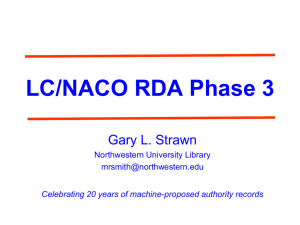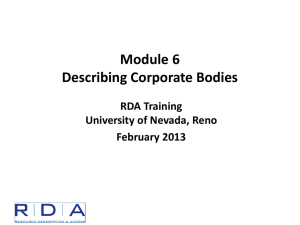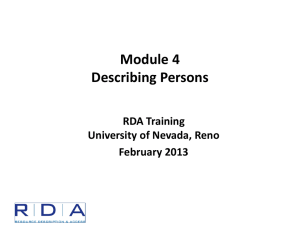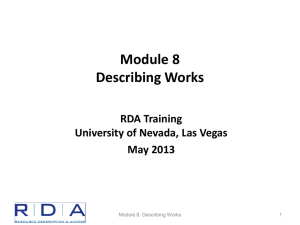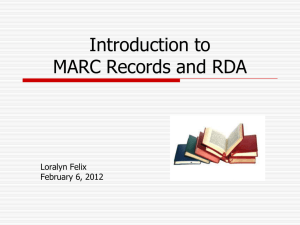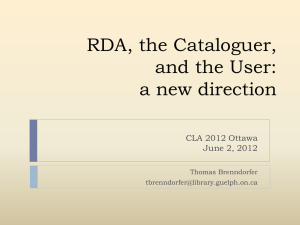Module 8 - Describing Works
advertisement
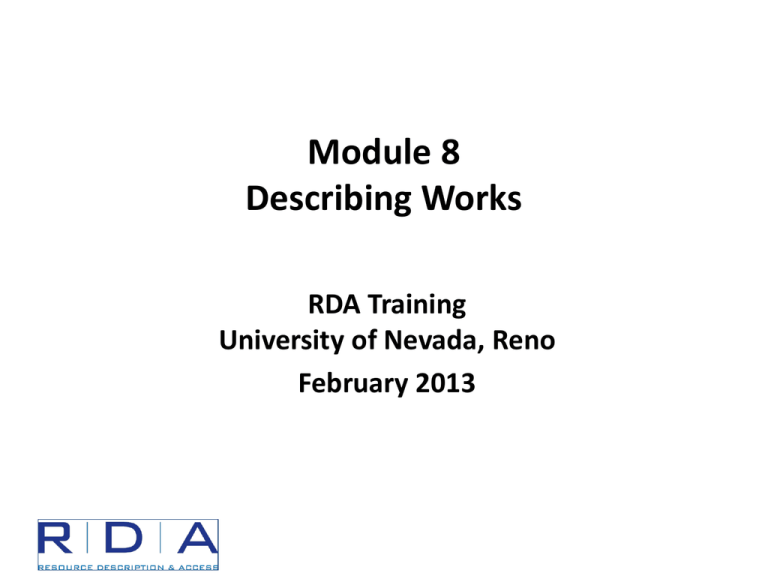
Module 8 Describing Works RDA Training University of Nevada, Reno February 2013 FRBR Primary Entities • Work • Expression • Manifestation • Item Module 8. Describing Works 2 RDA vs. AACR2 • AACR2 uniform title definition: “The particular title by which a work is to be identified for cataloguing purposes.” • Not, however, in fact an identifier for a work. • AACR2 uniform title combines aspects of work, expression, and sometimes even manifestation. Module 8. Describing Works 3 RDA vs. AACR2 AACR2 uniform title: Homer. Odyssey – Represents the work Odyssey as well as all Greek expressions of the Odyssey, of which there are many. Module 8. Describing Works 4 RDA vs. AACR2 RDA authorized access point for the work: Homer. Odyssey – Represents the work Odyssey only, not the Greek expressions RDA authorized access point for a Greek expression: Homer. Odyssey. Greek (Monro and Allen) – Represents the Greek expression of the Odyssey edited by David Monro and Thomas Allen Module 8. Describing Works 5 RDA vs. AACR2 AACR2 uniform title: Homer. Odyssey. Spanish – Represents all Spanish expressions (translations) of the Odyssey. There are many. Module 8. Describing Works 6 RDA vs. AACR2 RDA authorized access point for one of many Spanish expressions: Homer. Odyssey. Spanish (Alberich) – Represents the Spanish translation of the Odyssey by Joan Alberich. There are dozens of other Spanish translations. Module 8. Describing Works 7 RDA vs. AACR2 • Why is it important to be this precise? – Because RDA is working toward an entityrelationship structure, and in this structure each work and each expression will have a separate description. If the database uses access points, each description will need to have a distinct access point. – Even in the absence of an ER database, this precision will be helpful to our users. Module 8. Describing Works 8 FRBR Relationships (Groups 1-2) Work: Piedra de sol created by Person: Octavio Paz Expression: English realized through has a translation Expression: Spanish translated by Person: Muriel Rukeyser Module 8. Describing Works 9 Please log in to RDA • http://access.rdatoolkit.org/?username=RDAT raining&password=Wolfie13 • Reno Workshop: Please feel free to sign up later for a month’s free access so you can practice (see handout) Module 1. RDA Basics 10 Identifying Works: MARC Coding • Places are currently described in the MARC authority format. • RDA records identified by “z” in 008/10 (“Rules”) and $e rda in 040 Module 8. Describing Works 11 Identifying Works: Definition 5.1.2. The term work refers to a distinct intellectual or artistic creation (i.e., the intellectual or artistic content). The terms work and expression should be read, where applicable, to include not only an individual entity, but also aggregates and components of such entities (i.e., the term work should be read to include aggregate works and components of works as well as individual works, etc). Module 8. Describing Works 12 Identifying Works: Core Elements • Preferred title for the work • Identifier for the work • Musical works with non-distinctive titles – Medium of performance – Numeric designation – Key • Bilateral treaties – Signatory Module 8. Describing Works 13 Identifying Works: Core if needed to distinguish • • • • • Form of work Date of work Place of origin of the work Other distinguishing characteristic of the work Musical works with distinctive titles – Medium of performance – Numeric designation – Key Module 8. Describing Works 14 Identifying Works: Core Elements • The author / creator is not a core element of the work entity. • Authors can be persons, families, or corporate bodies, and they are separate entities, related to the work entity--an author has a relationship with a work • However, the access point will contain the name of the author, if there is one. This is a link, not an element of the work entity. Module 8. Describing Works 15 Identifying Works Transcription and Capitalization • Follow 1.7. General guidelines on transcription (not the alternatives) • 6.2.1.4. Capitalization. Follow Appendix A.3 and A.4. • 6.2.1.6. Diacritical marks: record them as they appear; add them if it is certain that they are integral to the title but were omitted in the source • 6.2.1.7. Omit initial articles (NACO follows the alternative) • 6.2.1.9. Abbreviations. Record only abbreviations that are found in the source. • 5.4. Language and script. NACO policy = Romanize vernacular scripts. Module 8. Describing Works 16 Transcription example Forms found for title: Piedra de Sol PIEDRA DE SOL Manipulation of capitalization according to Appendix A: Piedra de sol Module 8. Describing Works 17 RDA 5.8. Source Consulted • Record in 670 field, or 3XX $u/$v • Always include one 670 for the work being cataloged • Others included if needed to justify information in the description • Suggested format: 670 $a Title proper, date: $b citation (data) Module 8. Describing Works 18 670 field examples 670 $a The tragedy of Romeo and Juliet, 1982 670 $a Russian Wikipedia, June 19, 2012 $b (Анна Каренина = Anna Karenina; written 1873-1877, first publication 1875-1877) 670 $a Rin itsu shō, 2012: $b t.p. (源氏物語古注集成 = Genji monogatari kochū shūsei) 670 $a Homeri Odyssea, 1909670 $a Dr. Seuss's Green eggs and ham, 1995 Module 8. Describing Works 19 Identifying Works Sources of Information • Where can we get information about works? – 6.1.1: Take the title or titles of the work from any source. Take information on other identifying attributes of works and expressions from any source. Module 8. Describing Works 20 Identifying Works: Sources • Sources to check – The resource you are cataloging – The LC/NACO Authority File (authorities.loc.gov) – Your database (e.g. OCLC) – Optional: Other useful sources • Virtual International Authority File (http://viaf.org) • Wikipedia (http://www.wikipedia.org/) • Other sources such as encyclopedias and dictionaries Module 8. Describing Works 21 Attributes of Works: Title • Preferred title is a core element • Preferred title (modern works) – Chosen according to 6.2.2.4: “For works created after 1500, choose as the preferred title the title in the original language by which the work has become known through use in resources embodying the work or in reference sources.” Module 8. Describing Works 22 Attributes of Works: Title We find two possible titles for this work. Which would we choose as the preferred title? Module 8. Describing Works 23 Attributes of Works: Title • Preferred title (works created before 1501) – Chosen according to 6.2.2.5: “For works created before 1501, choose the title or form of title in the original language by which the work is identified in modern reference sources as the preferred title.” – Note special rules for Greek and anonymous works Module 8. Describing Works 24 Preferred title? Modern translation, published 2011 Module 8. Describing Works 25 Preferred title? Modern reference source: Oxford classical dictionary, 1996, p. 718 Module 8. Describing Works 26 Preferred title? Brill’s new Pauly dictionary of Greek and Latin authors and texts, 2009, p. 325326 Iliad (English)? Ilias (Latin)? Ἰλιάς (Greek)? Module 8. Describing Works 27 Attributes of Works: Preferred Title • Parts of works (6.2.2.9) – One part - choose preferred title as already shown • Two towers • King of the hill Can be generic (append to the preferred title of the work) • Episode 2, e.g. Downton Abbey. Season 1. Episode 2 • Introduction This side of paradise. Preface Module 8. Describing Works 28 Attributes of Works: Preferred Title • Parts of works (6.2.2.9) – More than one part • Numbered consecutive parts: give the general term in the singular with the number (append to the preferred title of the work) – Book 1-5, e.g. Commentary on the Epistle to the Romans. Book 1-5 • Unnumbered or nonconsecutive parts: either – Record each part separately (i.e. treat each as a single part) – Append “Selections” to the preferred title of the work as a whole, e.g., for a compilation called “Soliloquies from Hamlet” Hamlet. Selections Module 8. Describing Works 29 Attributes of Works: Preferred Title • Compilations of works (6.2.2.10) Either – Record each work separately and/or – Use a conventional collective title Module 8. Describing Works 30 Attributes of Works: Preferred Title • Compilations of works (6.2.2.10): conventional collective title – Compilation purports to be the complete works of an author, use Works – Compilation purports to be the complete works of an author in a single form, use one of the following: Correspondence Essays Novels Plays Poems Prose works Short stories Speeches • Or another appropriate specific collective title such as “Fragments” “Architectural drawings” etc. Module 8. Describing Works 31 Attributes of Works: Preferred Title • Compilations of works (6.2.2.10): conventional collective title – Compilation is less than the complete works of the author • • Either record each work separately and/or append the term “Selections” to the appropriate conventional collective title, e.g. Works. Selections Plays. Selections Speeches. Selections – NOTE: “Selections” can no longer stand alone. Module 8. Describing Works 32 Attributes of Works: Preferred Title (MARC) • Most RDA entity attributes have a discrete place in MARC to record them. Preferred title does not. It can only be recorded as part of the authorized access point for the work. • Record in the MARC authorities format 1XX field, indicators as appropriate to the field • Record the preferred title in subfield $t (100, 110, 111) or subfield $a (130). Other subfields may be appropriate Module 8. Describing Works 33 Attributes of Works: Preferred Title (MARC examples) The preferred title is bolded in each example 100 1 $a Carter, Jimmy, $d 1924- $t Living faith 100 1 $a Smith, Joseph, $c Jr., $d 1805-1844. $t King Follett discourse 100 0 $a Elizabeth $b I, $c Queen of England, $d 1533-1603. $t Correspondence 100 1 $a Mozart, Wolfgang Amadeus, $d 1756-1791. $t Works. $k Selections 110 2 $a Banco de Bilbao. $t Informe y memoria 110 1 $a United States. $b Department of Defense. $t Military commission order 130 0 $a Beowulf 130 0 $a Primary colors 130 0 $a Planet of the apes (Motion picture : 1968) Module 8. Describing Works 34 Attributes of Works: Variant Title Variant title (6.2.3) • Any version of the title that differs from the form chosen as the preferred title. Module 8. Describing Works 35 Attributes of Works: Variant Title (MARC) • Like the Preferred Title element, the Variant Title element (RDA 6.2.3) does not have a discrete place in MARC. It can only be recorded as part of the variant access point for the work. • Record in the MARC authorities format 4XX field, indicators as appropriate to the field • Record the variant title in subfield $t (400, 410, 411) or subfield $a (430). Other subfields may be appropriate Module 8. Describing Works 36 Attributes of Works: Variant Title (MARC examples) The variant title is bolded in each example 400 1 $a Carter, Jimmy, $d 1924- $t Personal beliefs of Jimmy Carter 400 1 $a Mozart, Wolfgang Amadeus, $d 1756-1791. $t Best of Mozart 410 2 $a Banco de Bilbao. $t Annual report and accounts 410 1 $a United States. $b Department of Defense. $t Department of Defense military commission order 430 0 $a Bjowulf 430 0 $a Primary colors 430 0 $a Monkey planet (Motion picture) Module 8. Describing Works 37 Attributes of Works: Form • RDA 6.3. Form of work is core if needed to differentiate the name of a work from the name of another entity (another work, or the name of a person, family, or corporate body) • It can be recorded as an element whether or not needed to distinguish • Record in MARC 380 field • There is no controlled vocabulary Module 8. Describing Works 38 Work Authority Record Piedra de sol, Iliad The form of both works is “Poem”. 380 $a Poem Exercise: Add this to the authority records. Module 8. Describing Works 39 Attributes of Works: Date • RDA 6.4. Date is defined as the earliest date associated with a work. Lacking other evidence, the date of the first publication may be used • Date is core only if needed to differentiate between a work and other entities with the same name. • The element may be recorded whether needed to distinguish or not. • Date is recorded in MARC 046 – Beginning date or single date = $k – Ending date = $l Module 8. Describing Works 40 Work Authority Record Piedra de sol This work was first published in 1957. The cataloger has no other information about the date of the work. 046 $k 1957 Exercise: add this field to the appropriate RDA authority record. Module 8. Describing Works 41 Work Authority Record Iliad According to Brill’s New Pauly this work was created in the second half of the 8th century BC. 046 $k -07 Exercise: add this field to the appropriate RDA authority record. Module 8. Describing Works 42 Attributes of Works: Place of Origin • RDA 6.5. Place of origin of the work is the country or other territorial jurisdiction from which a work originated. • It is not the setting of the work (what the work is “about”) • Information may be taken from any source. • Place of origin is core if needed to differentiate. • Whether core or not, the element may be recorded. • Place of origin is recorded in MARC 370 field $g Module 8. Describing Works 43 Recording the Place Attribute • The form of the place name is governed by RDA Chapter 16. • Authorized access points for jurisdictional place names are generally formed as in AACR2, e.g. “Paris (France)” However: • 16.2.2.4. “If the place name is being used to record ... the place of origin of a work ... precede the name of the larger place by a comma.” -- e.g. “Paris, France” Module 8. Describing Works 44 Recording the Place Attribute • 6.5.1.3 instructs us to follow chapter 16, including abbreviations; chapter 16 refers us to Appendix B. • B.11 is similar to the place names abbreviations list in AACR2 • So when recording this attribute for a person, use, e.g., “U.S.”, not “United States.” Module 8. Describing Works 45 Work Authority Record Piedra de sol The cataloger only knows that the place of origin of Piedra de sol is Mexico. This place is established as Mexico 370 $g Mexico Exercise: Record place of origin in the authority record Module 8. Describing Works 46 Work Authority Record Iliad According to Brill’s New Pauly, this work was created in Ionia (Asia Minor). This place is established as Ionia; Asia Minor is established as Turkey 370 $g Ionia $g Turkey Exercise: Record place of origin in the authority record Module 8. Describing Works 47 Attributes of Works: Place of Origin 046 $k 1495˜ $l 1497 $2 edtf 100 0 $a Leonardo, $c da Vinci, $d 1452-1519. $t Last supper 370 $g Milan, Italy 373 $a Santa Maria delle Grazie (Church : Milan, Italy) 380 $a Mural Module 8. Describing Works 48 Attributes of Works: Other Distinguishing Characteristics • 6.6. A characteristic that serves to differentiate the name of a work from another entity with the same name • Core if needed to differentiate • May be recorded, whether needed to distinguish or not – Various MARC fields • 046 (date) • 370 (place) • 373 (corporate body) • 380 (form) • 381 (anything else) Module 8. Describing Works 49 Attributes of Works: Other Distinguishing Characteristics 046 130 0 380 381 500 1 $k 1965 $a Harlow (Motion picture : 1965 : Segal) $a Motion picture $a Segal $w r $i Film director: $a Segal, Alex, $d 1915-1977 Module 8. Describing Works 50 Attributes of Works: Other RDA Elements • 6.7. History of the Work. Recorded in MARC 678 • 6.8. Identifier. Core element; LCCN, recorded in 010 • Musical works: RDA 6.14-6.18 • Legal works: RDA 6.19-6.22 • Religious works: RDA 6.26 Module 8. Describing Works 51 A Brief Whirl Through Musical Works • Most of the attributes of other works also apply to musical works, but – Titles (some differences) – Attributes applicable only to musical works • Medium of performance • Numeric designation • Key Module 8. Describing Works 52 Attributes of Musical Works: Preferred Title • 6.14.2.3. “Choose as the preferred title for a musical work the composer’s original title in the language in which it was presented.” Die Zauberflöte Missa luba Lip my reeds • Basically the same as for other works. BUT ... Module 8. Describing Works 53 Attributes of Musical Works: Preferred Title manipulation • Titles of musical works are manipulated before recording • 6.14.2.4. Remove: – medium of performance – key – any numbers unless integral to the title – date of composition – NACO catalogers also remove initial articles (6.2.1.7 alternative) Module 8. Describing Works 54 Attributes of Musical Works: Preferred Title manipulation Sonata in G major for two double basses becomes Sonata [remove key, medium of performance] Trio for flute, viola, and piano, 1948 becomes Trio [remove medium of performance, date of composition] Sofien-Tänze für das Piano-Forte, 185tes Werk becomes Sofien-Tänze [remove medium of performance, opus number] Die Zauberflöte becomes Zauberflöte [remove initial article] Module 8. Describing Works 55 Attributes of Musical Works: Preferred Title manipulation If the result of 6.14.2.5 is solely the name of one type of composition, record it in English, if there’s an English form, and record in the plural unless the composer wrote only one work of the type. Sonata in G major for two double basses becomes Sonata [remove key, medium of performance] becomes Sonatas Trio for flute, viola, and piano, 1948 becomes Trio [remove medium of performance, date of composition] becomes Trios Sofien-Tänze für das Piano-Forte, 185tes Werk becomes Sofien-Tänze [remove medium of performance, opus number] remains Sofien-Tänze Die Zauberflöte becomes Zauberflöte [remove initial article] remains Zauberflöte Module 8. Describing Works 56 Attributes of Musical Works: Preferred Title manipulation Stay tuned! We’ll add some of these things back in when we create the authorized access point. Module 8. Describing Works 57 Attributes of Musical Works: Medium of Performance • 6.15. Medium of performance is is the instrument, instruments, voice, voices, etc., for which a musical work was originally conceived. • Record according to the instructions in 6.15.1.3. • Record in MARC authority 382 field, subfield $a Module 8. Describing Works 58 Attributes of Musical Works: Medium of Performance 382 $a orchestra 382 $a mixed voices $a orchestra 382 $a organ 382 $a countertenor $a keyboard 382 $a bassoon $a tuba 382 $a mezzo-soprano $a piano 382 $a flute $a oboe $a bassoon $a trombone $a violin $a contrabass Module 8. Describing Works 59 Attributes of Musical Works: Numeric Designation • 6.16. Serial number, opus number, or thematic index number • Record in MARC authorities 383 field – – – – – $a Serial number $b Opus number $c Thematic index number $d Thematic index code $e Publisher associated with opus number • $d codes: http://bcc.musiclibraryassoc.org/BCCHistorical/BCC2011/Thematic_Indexes.htm Module 8. Describing Works 60 Attributes of Musical Works: Numeric Designation Serial number 383 $a no. 26 Opus number 383 $b op. 15 Serial and opus number 383 $a no. 4 $b op. 53 Thematic index number 383 $c K. 537 $d Köchel6 $2 mlati 383 $c BWV 211 $d Wohlfarth $2 mlati Module 8. Describing Works 61 Attributes of Musical Works: Key (6.17) • Key is determined by the adherence of a musical work (or a part of a musical work) to the note pattern of a major or minor scale. • If the key can be determined, record it in a MARC authority 384 field, first indicator “0”, subfield $a. Module 8. Describing Works 62 Attributes of Musical Works: Key (6.17) 384 0 384 0 384 0 384 0 384 0 $a B♭ major $a D minor $a F major $a A minor $a C♯ major Module 8. Describing Works 63 Preferred Title of a Religious Work Sacred Scripture (Parts of the Bible) • O.T. and N.T. are no longer abbreviated. “Old Testament” and “New Testament” will be used. • Individual books are no longer grouped under a testament. 130 0 $a Bible. $p New Testament not 130 0 $a Bible. $p N.T. 130 0 $a Bible. $p Leviticus not 130 0 $a Bible. $p O.T. $p Leviticus Module 8. Describing Works 64 Bible Preferred Titles AACR2 Bible. O.T. Genesis Bible. O.T. Pentateuch Bible. N.T. Mark Bible. N.T. Pastoral Epistles Bible. N.T. RDA Bible. Genesis Bible. Pentateuch Bible. Mark Bible. Pastoral Epistles Bible. New Testament [used only for the entire New Testament, not individual books] Module 8. Describing Works 65 Constructing the Authorized Access Point for a Work (RDA 6.27.1) • Works created by one person, family, or corporate body (6.27.1.2) a. Record the authorized access point for the person, family, or corporate body (this serves as a link to the record for the creator) b. Record the preferred title of the work • Use MARC 1XX field. – Authorized access point for creator identical to form in its own record, with identical subfield coding – Preferred title of work in subfield $t, $n, $p, $k Module 8. Describing Works 66 Constructing the Authorized Access Point for a Work (RDA 6.27.1) • Collaborative works (6.27.1.3) a. Record the authorized access point for the person, family, or corporate body with principal responsibility for the work (this serves as a link to the record for the creator) [NOTE: No “rule of three”] b. Record the preferred title of the work • Use MARC 1XX field. – Authorized access point for principal creator identical to form in its own record, with identical subfield coding – Preferred title of work in subfield $t, $n, $p, $k Module 8. Describing Works 67 Constructing the Authorized Access Point for a Work (RDA 6.27.1) • Collaborative works (6.27.1.3) – Corporate bodies can be creators (19.2.1.1.1) a. b. c. d. e. f. g. Works of an administrative nature dealing with the body itself Works that record the collective thought of the body Works that report the collective activity of a meeting, expedition, or event Some works that result from the collective activity of a performing group Cartographic works originating with a corporate body Certain legal works Named works of art by two or more artists acting as a corporate body Module 8. Describing Works 68 Constructing the Authorized Access Point for a Work (RDA 6.27.1) • Collaborative works (6.27.1.3) – Moving image works The access point is created by recording the preferred title alone (no access point for creator) – NOTE: this applies to most motion pictures, which are usually collaborative works. If a motion picture is the work of a single person, family, or corporate body, its access point is created according to 6.27.1.2 (authorized access point for creator + preferred title of the work) Module 8. Describing Works 69 Constructing the Authorized Access Point for a Work (RDA 6.27.1) • Compilations of works by different persons, families, or corporate bodies (6.27.1.4) – The access point is created by recording the preferred title alone (no access point for any creator) – The preferred title is the collective title for the compilation (an aggregate work) – If there is no collective title, separate access points are constructed for the individual works in the compilation Module 8. Describing Works 70 Constructing the Authorized Access Point for a Work (RDA 6.27.1) • Works of uncertain or unknown origin (6.27.1.8) – The access point is created by recording the preferred title alone (no access point for any creator) Module 8. Describing Works 71 Constructing the Authorized Access Point for a Work (RDA 6.27.1) • Additions to the access point (6.27.1.9) • Additions are made, in parentheses, if the authorized access point is the same or similar to that of another work. Add: – Form of the work • Charlemagne (Play) – Date of the work • Dublin magazine (1762) – Place of origin of the work • Advocate (Boise, Idaho) – Other distinguishing characteristic • Bulletin (Geological Survey (South Africa)) Module 8. Describing Works 72 Constructing the Authorized Access Point for a Work (MARC) 100 1 $a Carter, Jimmy, $d 1924- $t Living faith 100 1 $a Smith, Joseph, $c Jr., $d 1805-1844. $t King Follett discourse 100 1 $a Mozart, Wolfgang Amadeus, $d 1756-1791. $t Works. $k Selections 110 2 $a Banco de Bilbao. $t Informe y memoria 130 0 $a Beowulf 130 0 $a Primary colors 130 0 $a Planet of the apes (Motion picture : 1968) 130 0 $a Encyclopaedia Britannica 130 0 $a Bible. $p Genesis 130 0 $a Bible. $p New Testament 130 0 $a NuTCRACKER (Computer file) Module 8. Describing Works 73 Constructing the Authorized Access Point for a Musical Work • We promised we’d come back to this :-) • Basically constructed like any other work: – combine the authorized access point for the composer with the preferred title of the work • Except (of course), musical works with preferred titles that are not distinctive (the titles we created by removing parts) Module 8. Describing Works 74 Constructing the Authorized Access Point for a Musical Work • Musical works with preferred titles that are not distinctive (the title is only a type of composition) (6.28.1.9) • Add to the authorized access point as available: – Medium of performance ($m, preceded by comma) – Numeric designation ($n, preceded by a comma) – Key ($r, preceded by a comma) Module 8. Describing Works 75 Constructing the Authorized Access Point for a Musical Work (MARC) 100 1 $a Handel, George Frideric, $d 1685-1759. $t Water music 100 1 $a Bach, P. D. Q., $d 1742-1807. $t Madrigals from The triumphs of Thusnelda. $p My bonnie lass she smelleth 100 1 $a Mozart, Wolfgang Amadeus, $d 1756-1791. $t Concertos, $m piano, orchestra, $n K. 537, $r D major 100 1 $a Michelet, Michel, $d 1894-1995. $t Sonatas, $m balalaika, piano Module 8. Describing Works 76 Constructing Variant Access Points for a Work (RDA 6.27.4) Variant access points are not core. Include them if in your judgment they would help the user find or identify the work. – Begin with a variant title (6.2.3) – Construct the variant access point by combining the authorized access point for the creator with the variant title or by giving the variant title alone – Make further additions to the access point if you consider them to be important for identification in the same way such additions would have been added to a preferred title. These additions are not required. Module 8. Describing Works 77 Related Works (RDA 25) Related works are recorded in 5XX fields, and may include a relationship indicator in subfield $i (from RDA Appendix J), with $w r. 100 1 $a Bach, P. D. Q., $d 1742-1807. $t Madrigals from The triumphs of Thusnelda. $p My bonnie lass she smelleth 500 1 $w r $i Parody of (work): $a Morley, Thomas, $d 1557-1603? $t Balletts. $p My bonny lasse shee smyleth Module 8. Describing Works 78 Exercises • Create on worksheets descriptions of the works Iliad and Piedra de sol • Create authority records for works that workshop participants have brought Module 8. Describing Works 79 RDA authority record core and non-core: work record 040 046 100 1 370 380 670 $a UPB $b eng $e rda $c UPB $k 1957 $a Paz, Octavio, $d 1914-1998. $t Piedra de sol $g Mexico $a Poem $a Piedra de sol, 1957 Module 8. Describing Works 80 RDA authority record core and non-core: work record 040 $a UPB $b eng $e rda $c UPB 046 $k -07 100 0 $a Homer. $t Iliad 370 $g Ionia $g Turkey 380 $a Poem 400 0 $a Homer. $t Ilias 400 0 $a Homer. $t Ἰλιάς 670 $a The Iliad, 2011: $b title page ([by] Homer) 670 $a Oxford classical dictionary, 1996: $b page 718 (Iliad; attributed in the ancient world to Homer) 670 $a Brill’s new Pauly dictionary of Greek and Latin authors and texts, 2009: $b pages 325-326 (Iliad (English); Ilias (Latin); Ἰλιάς (Greek); by Homer, created second half of 8th century BC in Ionia (Asia minor)) Module 8. Describing Works 81 Module 8 Describing Works QUESTIONS? RDA Training University of Nevada, Reno February 2013 This Presentation is available at http://net.lib.byu.edu/~catalog/people/rlm/ RDAReno201302/index.htm For further information contact Robert L. Maxwell robert_maxwell@byu.edu Module 1. RDA Basics 83

